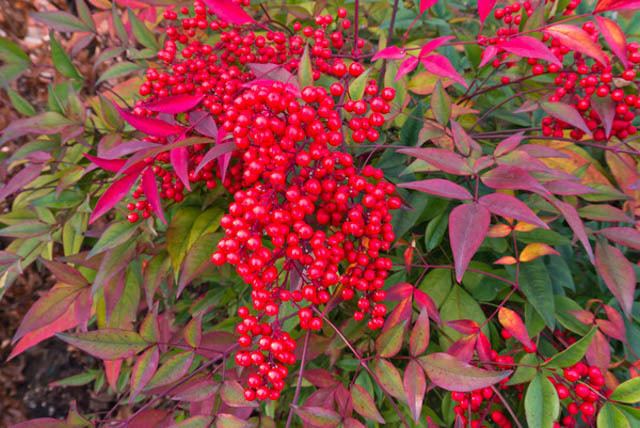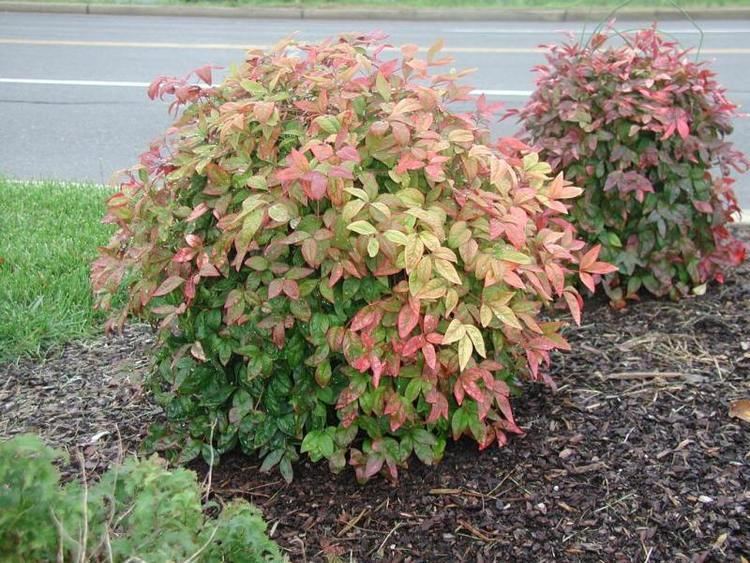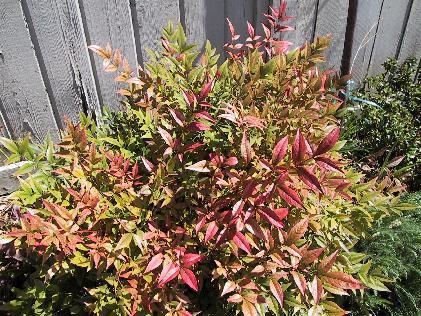Scientific name Nandina Rank Genus | Species N. domestica | |
 | ||
Similar Nandina, Berberidaceae, Barberry, Loropetalum, Abelia | ||
Dwarf heavenly bamboo nandina domestica firepower
Nandina domestica (/nænˈdiːnə dəˈmɛstᵻkə/ nan-DEE-nuh) commonly known as nandina, heavenly bamboo or sacred bamboo, is a species of flowering plant in the family Berberidaceae, native to eastern Asia from the Himalayas to Japan. It is the only member of the monotypic genus Nandina.
Contents
- Dwarf heavenly bamboo nandina domestica firepower
- How to prune nandina domestica
- Description
- Toxicity
- Status as an invasive species
- Garden history and cultivation
- References

How to prune nandina domestica
Description

Despite the common name, it is not a bamboo but an erect evergreen shrub up to 2 m (7 ft) tall by 1.5 m (5 ft) wide, with numerous, usually unbranched stems growing from ground level. The glossy leaves are sometimes deciduous in colder areas, 50–100 cm (20–39 in) long, bi- to tri-pinnately compound, with the individual leaflets 4–11 cm (2–4 in) long and 1.5–3 cm broad. The young leaves in spring are brightly coloured pink to red before turning green; old leaves turn red or purple again before falling. The flowers are white, borne in early summer in conical clusters held well above the foliage. The fruit is a bright red berry 5–10 mm diameter, ripening in late autumn and often persisting through the winter.
Toxicity

Cedar waxwings are subject to cyanide toxicosis from eating the berries, resulting in death to multiple birds at one time.

All parts of the plant are poisonous, containing compounds that decompose to produce hydrogen cyanide, and could potentially be fatal if ingested. The plant is placed in Toxicity Category 4, the category "generally considered non-toxic to humans," but the berries are considered toxic to cats and grazing animals. Excessive consumption of the berries will kill birds such as Cedar Waxwings. The berries also contain alkaloids such as nantenine, which is used in scientific research as an antidote to MDMA.
Status as an invasive species

Nandina is considered invasive in North Carolina, Tennessee, Georgia, and Florida. It was placed on the Florida Exotic Pest Plant Council’s invasive list as a Category I species, the highest listing. It has been observed in the wild in Florida in Gadsden, Leon, Jackson, Alachua and Citrus counties, in conservation areas, woodlands and floodplains. In general, the purchase or continued cultivation of non-sterile varieties in the southeastern United States is discouraged.

Although grown extensively in Texas because of its tolerance for dry conditions, fruiting varieties of Nandina are considered invasive there. This is primarily due to birds spreading seeds into natural areas where Nandina proliferates and crowds out native species, both through seeding and by the growth of rhizomatous underground stems.
Garden history and cultivation
N. domestica, grown in Chinese and Japanese gardens for centuries, was brought to Western gardens by William Kerr, who sent it to London in his first consignment from Canton, in 1804. The English, unsure of its hardiness, kept it in greenhouses at first. The scientific name given to it by Carl Peter Thunberg is a Latinized version of a Japanese name for the plant, nan-ten. Nandina is widely grown in gardens as an ornamental plant. Over 65 cultivars have been named in Japan, where the species is particularly popular and a national Nandina society exists. In Shanghai berried sprays of nandina are sold in the streets at New Year, for the decoration of house altars and temples.
Nandina does not berry profusely in Great Britain, but it can be grown in USDA hardiness zones 6–10 with some cultivars hardy into zone 5. Nandina can take heat and cold, from −10–110 °F (−23–43 °C). A true low-care plant, it needs no pruning, unless it is to harvest some leaves for use in a flower arrangement or berries for a holiday centerpiece, or occasionally to remove an old cane. The berries can also be left on the plants for birds to harvest in late winter. Spent berry stalks can easily be snapped off by hand in spring. Due to the naturally occurring phytochemicals (see above) this plant is commonly used in rabbit, deer, and javelina resistant landscape plantings.
